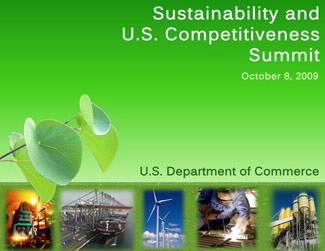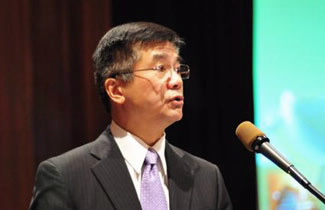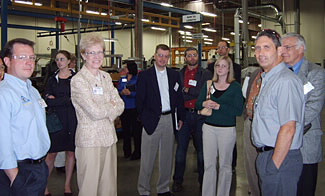Morgan Barr is an International Economist with the Office of Trade Policy Analysis. She has been working on the Sustainable Manufacturing Initiative for two years and started in the office as a SCEP focusing on earning her MBA and MA in international affairs from the George Washington University.
On October 8, our Sustainable Manufacturing Initiative team hosted the Sustainability and U.S. Competitiveness Summit at the Commerce Department. The event was a complete success. We had more than 120 representatives from private industry, industry associations, non-governmental organizations, academia and major federal agencies in attendance. The Summit was a follow up to a similar event we held in 2007, and we wanted to report to our stakeholders on the work we’ve done since then. We also wanted to gain input from attendees on possible areas of future work for our initiative.

Sustainability Summit Event Poster
The enthusiasm from the attendees was tremendous. We had two extended coffee breaks and a lunch session where attendees could network and meet with representatives from various government agencies to learn about the programs and resources that are available to help them.
The event began with opening remarks from Secretary Gary Locke, who stressed the importance of manufacturing as a source of well-paying jobs and emphasized the role that sustainable practices can play in lowering costs and making manufacturers more competitive. The Secretary was followed by Gary Guzy, Deputy Director and General Counsel for the White House Council on Environmental Quality, who discussed the plans for the development of the “green economy”.

Secretary of Commerce Gary Locke speaks at the Sustainability Summit. (U.S. Department of Commerce photo)
Then our team presented its work. In the past two years, we’ve created an interagency group on sustainable manufacturing to coordinate action across the government, and we’ve also held a series of regional facility tours—or SMARTs—to promote the adoption of sustainable practices. Our newest deliverable is our Sustainable Business Program and Resource Clearinghouse—a searchable central database that includes numerous federal government programs and resources to support sustainable business and manufacturing practices.
We’re also working on a study being conducted in the Organization for Economic Cooperation and Development (OECD) on simplified metrics for sustainable manufacturing. Michael Bordt of the OECD presented his work to date on the study, which will include an easy-to-use toolkit with a simplified set of metrics and guidance on how companies can use them to help make business decisions about improving their environmental performance. You can read more about the study and our other projects on our website.

Attendees at the Sustainability Summit exchange explore the displays in the Commerce Department's lobby. (U.S. Department of Commerce photo)
In the afternoon, Andrew Winston, co-author of Green to Gold, and author of Green Recovery, gave an excellent keynote address on the linkages between sustainability and competitiveness. His address really set the stage for the afternoon breakout sessions where attendees met in smaller groups to discuss the morning’s presentations, the challenges they’ve faced implementing sustainable business practices, and areas where the government can potentially aid the private sector in its endeavors. The discussion in the sessions was excellent, and we’re going to use the individual input, along with other factors, when we’re planning our future work on the initiative.



